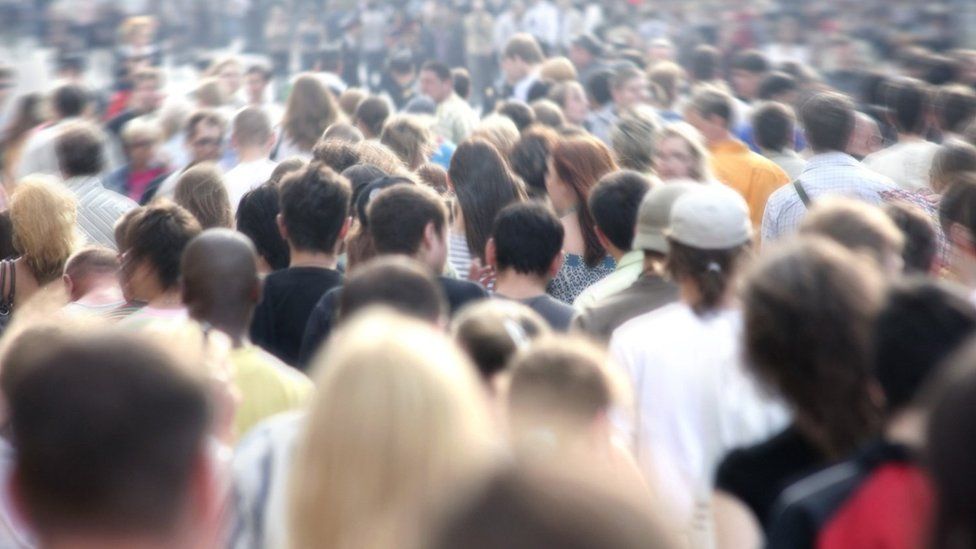 Getty Images
Getty ImagesAbout 1.5 million people in England and Wales identify as LGB+, census data has revealed for the first time.
More than 1.5% of the population – 748,000 – identify as gay or lesbian, 624,000 (1.3%) as bisexual and 165,000 as “other” sexual orientations.
Some 262,000 people (0.24%) said their gender identity was different to their sex registered at birth.
This is the first census that has asked people about their sexual orientation and gender identity.
- What is a census and do I need to complete it??
- Less than half of population Christian for first time
- Rise in overseas-born people in England and Wales
The census, which took place in England and Wales on 21 March 2021, offers a snapshot of the population. The total population of England and Wales is about 59.6 million.
Before it was circulated, the government said the information would provide evidence about inequalities to tackle discrimination and improve decisions made about health care, education, employment, housing and social services for lesbian, gay and bisexual people.
Completing this section of the census was voluntary.
The decision to include a voluntary question about gender identity in England and Wales was welcomed by some charities as a “step in the right direction”.
Research suggested that asking just the one question in previous censuses about a person’s sex was a “barrier” to some taking part who felt it did not apply to them.
Smaller surveys have indicated that less than 2% of the population of England and Wales currently identify as lesbian or gay.
Previously the government estimated there to be between 200,000 and 500,000 transgender people in the UK.
Census respondents were asked voluntary questions about their sexual orientation, and whether their gender identity is different to their sex registered at birth.
Around 3.6 million people (7.5%) did not answer the question on sexual orientation, while 2.9 million (6.0%) chose not to disclose their gender identity.
Those who did answer were able to select from options including heterosexual, gay, lesbian and bisexual. They could also select “other” and fill in a text box describing their sexual orientation.

Of those who selected “other sexual orientation”:
112,000 (0.23%) identified as pansexual
- 28,000 (0.06%) described themselves as asexual
- 15,000 (0.03%) said they were queer
- 10,000 (0.02%) wrote in a different sexual orientation
Respondents were also asked whether their gender identity matched their sex registered at birth. Those who selected “no” were asked to fill in a text box describing their gender identity.

Of these:
- 118,000 (0.24%) selected “No” but did not provide a written response.
- 30,000 (0.06%) identified as non-binary, an umbrella term for those who do not identify as exclusively male or female.
- 18,000 (0.04%) wrote down a different gender identity.
Those aged 16 or over who did not wish for their answers to be revealed to other members of their household were able to submit a separate form to keep their answers anonymous.
Jen Woolford, Population Director for the Office for National Statistics (ONS), the body responsible for carrying out the census, said the data will help to “tackle inequalities” in the LGBT+ community.
She said: “We’ve introduced those questions as a reflection of of our society becoming more diverse, but also because there are now clear user needs for more information on that kind of diversity and the richness of our population.”
‘Landmark moment’
Dr Kevin Guyan, Research Fellow at the University of Glasgow and LGBT data expert, has called the information a “landmark moment for inclusion”.
He urged that the figures be used to benefit communities.
“The data will not, on its own, address issues negatively impacting many LGBT people such as the cost-of-living crisis, access to healthcare and affordable housing,” he said. “It must be understood as the first step in a longer project of change.”
Matthew Belfield, spokesperson for Manchester-based charity the LGBT Foundation, said the data will help them better target services across the country.
He said: “Manchester is such a hot spot for the LGBTQ+ community, but other communities aren’t so lucky.
“By asking these type of questions on a national level, it means that resources will be allocated in the correct way, that their communities will have their needs addressed.”

Scotland’s census was delayed due to the pandemic, but its responses are expected to be released later this year.
Northern Ireland’s didn’t include a question about gender identity. The responses to its question on sexual orientation are also due to be published this year.
- Bisexuality more visible but ‘work to do’ on safety
- ‘The day I told my boyfriend I was non-binary’
- Pride at 50: ‘There was a sense of naughtiness’
Information about how age groups and ethnicity intersect with these figures hasn’t yet been released. However, previous surveys found 16-24-year-olds are more likely to identify as lesbian, gay or bisexual, and in recent years there has been a small gradual decline in the number of people identifying as exclusively straight.
Canada is the only other country so far to have released data related to gender identity.
New Zealand will also include similar questions in its census in 2023.
-
Less than half of population Christian for first time
-
29 November 2022

-
-
Rise in overseas-born people in England and Wales
-
2 November 2022

-
